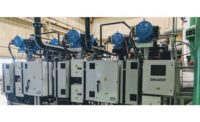Washington, DC –The federal economic stimulus package is intended to create and save 3.6 million jobs and jumpstart the economy with economic recovery tax cuts and targeted investments. In addition to putting money back in the pockets of consumers and businesses, the package also includes provisions that will help achieve long-term goals, such as improving energy efficiency in both the public and private sectors.
Among those provisions, the plan calls for a disbursement of $6.9 billion to state and local governments for energy efficiency upgrades and the reduction of carbon emissions, which amounts to an average of $100 million to each state. By investing a portion of this $100 million in rebates or low interest loans to homeowners who replace their old fossil fuel or electric furnaces with geothermal heat pumps, the country would definitely make progress toward the goals of the stimulus package. States that have invested in similar programs were able to create hundreds of “green collar jobs” while significantly increasing energy efficiency and reducing carbon emissions.
Green Jobs.An additional state $2,000 rebate on the purchase of a geothermal heat pump – or the availability of low interest loans – could generate an additional 200 heat pump sales every month in a typical state, or 2,400 geothermal heat pump unit sales at the end of the first year. Further, every 18 heat pump installations can create one new job. By the end of the first year that means 133 new green collar jobs can be created (2,400 units divided by 18 installations per job). At $2,000 per unit, the total cost of a job creation/energy efficiency rebate program would be $4.8 million over the course of a year.
Every geothermal heat pump requires 24 hours of manufacturing labor and 32 hours of installation labor. Small businesses involved in the installation include heating and air-conditioning contractors, electricians, plumbers, excavators and drilling machine operators. These businesses have the capacity and technical skills to begin installing green geothermal technology in more homes immediately.
Reduced Carbon Footprint.In addition to creating jobs, a rebate program and the ensuing installation of geothermal heat pumps would cut an average four metric tons of carbon emissions per year per unit, due to the high energy efficiency of geothermal heat pump technology. This means that for the average unit life of 24.4 years, 97.6 metric tons of emissions could be eliminated over the lifetime of each unit, and 234,240 tons over the lifetime of every 2,400 units sold through a state rebate program.
A recent paper published by Oak Ridge National Laboratory estimated that aggressive deployment of geothermal heat pumps could achieve 35 to 40 percent of a recommended carbon reduction path for the U.S. building sector.
If every state takes at least five percent of the funding available through the energy efficiency portion of the stimulus package and invests it in a geothermal heat pump incentive, there couldn’t be a more cost effective, greener way to put people back to work, save fossil fuel, reduce carbon emissions and save homeowners thousands of dollars per year for the next 24 years. It’s the stimulus that keeps on stimulating.
Economic Recovery.The stimulus package funding is critical to a U.S. heating and air-conditioning industry that has been hit hard by the recession. The collapse of the residential new construction market and the lack of consumer financing have slammed the industry over the past two years, and heating system sales were down to levels not seen since 1970.
Geothermal heat pumps are built by manufacturers in the United States at domestic plants in nine states, and geothermal systems are operating and saving energy in all 50 states and are being exported around the globe.
For more information, contact the Geothermal Heat Pump Consortium at 888.255.4436 or visitwww.GeoExchange.org.
Get our new eMagazine delivered to your inbox every month.
Stay in the know on the latest HVACR engineering trends.
SUBSCRIBE TODAY!Copyright ©2024. All Rights Reserved BNP Media.
Design, CMS, Hosting & Web Development :: ePublishing




